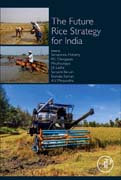
The Future Rice Strategy for India
Mohanty, Samarendu
Chengappa, P. G.
Hedge, Mruthunjaya
Ladha, J.K.
Baruah, Sampriti
Kannan, Elumalai
Manjunatha, A. V.
The Future Rice Strategy for India presents forward-looking insights toward achieving sustainable development of the rice sector, ensuring future food and nutritional security. As a staple food for many in India, including the economically disadvantaged, there are many concerns that affect the development of rice sector. Facing issues from environmental demands to economic stagnation, access to food, food inflation, and the Food Security Act (demand - supply - distribution of rice) achieving sustainability in production and exports is an important and urgent challenge. Using case studies to illustrate existing and potential issues, challenges and solutions, The Future Rice Strategy for India presents key strategic options while considering the implicit consequences. In addition, the findings enrich the strategy and policy formulation considerations for the role of rice in the country. This multidisciplinary approach features the expertise of rice scientists covering different aspects of rice sector; from breeding to consumer preferences and markets and trade. Uses analysis based on agro ecological zones (AEZ) patterns providing understanding of future growth patterns based on rice ecologiesIncludes case studies with proposed solutions taking into consideration pros and cons of each, allowing readers facing similar concerns and issues to identify an appropriate solution more efficiently and effectively INDICE: 1 Introduction and Objectives (Samrendu Mohanthy, International Rice Research Institute; P G Chengappa, ICAR, National Professor, Institure for Social and Economic Change; Mruthunjaya, Former National Director, ICAR, Elumalai Kannan, ISEC; A V Manjunatha, ISEC and Sampriti Baruah, IRRI) 2 Broad Settings 2.1. Spatial and temporal pattern of rice production and productivity Parvesh Chandna, GIS Specialist, IRRI; Elumalai Kannan, Assistant Professor, ISEC and P. Samal, Principal Scientist, Central Rice Research Institute, Cuttack. 2.1.1. Characterisation/typologies based on geographical settings 2.1.2. Different rice growing systems 2.1.3. Water use in rice production (groundwater and surface) 2.1.4. Biotic and abiotic stress mapping 2.1.5. Yield gap analysis (assessing yield gaps, and management of pests and diseases, crop management practise, socio-economic gap) 2.1.6. Productivity across regions over time 2.1.7. Total Factor Productivity 2.1.8. Decomposition of Total Factor Productivity 2.1.9. Input use efficiency 2.1.10.Cost of production and profitability 2.2. Sustainability of rice production systems Anjani Kumar, Research Fellow, International Food Policy Research Institute; R. S. Sidhu, Punjab Agriculture University and Ashok KR, Tamil Nadu Agriculture University 2.2.1 Sustainability of rice production in traditional areas (IGP, Tamil Nadu and Andhra Pradesh) 2.2.2. Rice and climate change 2.2.3 Climatic variations (drought, flood, rising sea level-salinity, temperature, rainfall, sunshine hours) 2.2.4.Adaptation and mitigation 2.2.5. Improving rice yields 2.2.6. Developing market for rice 2.3. Climate change and environmental footprint of rice production R Balasubramainan, Tamil Nadu Agriculture University; V Sarvana Kumar and K Boomiraj Suggested contents to be included in this chapter 2.3.1. Greenhouse gas emission 2.3.2. Pesticide and fertiliser residue 2.3.3. Pollution of groundwater 2.3.4. Straw burning 2.4. Structural transformation of Indian rice sector Humnath Bhandari, IRRI and Praduman Kumar, Indian Agricultural Research Institute (IARI) Suggested contents to be included in this chapter 2.4.1. Change in land use pattern: fragmentation of holding, diversification of agriculture 2.4.2. Vertical integration of rice value chain 2.4.3. Credit availability 2.4.4. Changing role of women and youth in rice value chain 2.4.5. Demand Trends 2.4.6. Changing consumption patterns across regions and income groups 2.4.7. Consumption of rice by types (basmati and non-basmati) 2.4.8.Consumption of rice as processed products and home away consumption of healthier and nutritionally enhanced rice 2.4.8 Supply Trends 2.4.9. Area constraints (urbanization, climate change, competition from other crops, etc.) 2.4.10. Yield trends 2.4.11. Medium- to long-term supply and demand projections 2.4.12. Scenario analysis (yield growth, GDP growth, and policy structure)
- ISBN: 978-0-12-813936-3
- Editorial: Academic Press
- Encuadernacion: Cartoné
- Páginas: 516
- Fecha Publicación: 01/06/2017
- Nº Volúmenes: 1
- Idioma: Inglés
